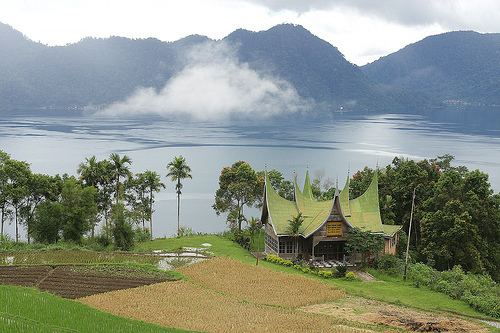Type Caldera lake Max. width 7 km (4.3 mi) Surface elevation 459 m Width 7 km | Primary outflows Antokan River Max. length 16 km (9.9 mi) Area 99.5 km² Length 16 km | |
 | ||
Similar Lake Singkarak, Puncak Lawang, Jam Gadang, Pagaruyung Kingdom, Ngarai Sianok | ||
Lake Maninjau (Indonesian: 'Danau Maninjau', meaning overlook or observation in the Minangkabau language) is a caldera lake in West Sumatra, Indonesia. It is located 36 km to the west of Bukittinggi, at 0°19′S 100°12′E.
Contents
- Map of Lake Maninjau Tanjung Raya Agam Regency West Sumatra Indonesia
- Formation
- The lake
- Local fishing and agriculture
- Soekarnos pantun
- References
Map of Lake Maninjau, Tanjung Raya, Agam Regency, West Sumatra, Indonesia
Formation
The Maninjau caldera was formed by a volcanic eruption estimated to have occurred around 52,000 years ago. Deposits from the eruption have been found in a radial distribution around Maninjau extending up to 50 km to the east, 75 km to the southeast, and west to the present coastline. The deposits are estimated to be distributed over 8500 km² and have a volume of 220–250 km³. The caldera has a length of 20 km and a width of 8 km.
The lake
Lake Maninjau has an area of 99.5 km², being approximately 16 km long and 7 km wide. The average depth is 105 m, with a maximum depth of 165 m. The natural outlet for excess water is the Antokan river, located on the west side of the lake. It is the only lake in Sumatra which has a natural outlet to the west coast. Since 1983 this water has been used to generate hydroelectric power for West Sumatra, generated around 68 MW at maximum load.
Most of the people who live around Lake Maninjau are ethnically Minangkabau. Villages on the shores of the lake include Maninjau and Bayur.
Maninjau is a notable tourist destination in the region due to its scenic beauty and mild climate. It is also used as a site for paragliding.
Local fishing and agriculture
Two endemic species collected from the lake for local consumption and for export to markets outside the crater are pensi, a species of small mussel, and palai rinuak, a type of small fish. One method of preparing palai rinuak is to grill a mixture of the fish along with coconut and spices, wrapped in a banana leaf.
The lake is used for aquaculture, using karamba floating net cages. The technique was introduced in 1992, and by 1997 there were over 2,000 cage units with over 600 households engaged. Each cage may have 3-4 production cycles each year. There is evidence of pollution around some karamba area.
On the edge of the lake, the landuse includes rice fields in the swamps and the lower slopes. The villages are bordered uphill by a large belt of forestlike tree gardens, which dissolves into the upper montane forest on the steepest parts of the slopes up to the ridge of the caldera.
The tree gardens include three typical components:
Soekarno's pantun
The first president of Indonesia, Sukarno, visited the area in early June 1948. A pantun he wrote about the lake reads:
Jangan dimakan arai pinang,
Kalau tidak dengan sirih hijau.
Jangan datang ke Ranah Minang,
Kalau tidak singgah ke Maninjau.
Do not eat arai nut,
If not with a green betel.
Do not come to Minang lands,
If you do not stop at Maninjau.
